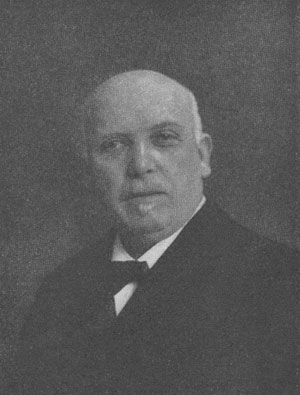Dines Andersen
 DINES ANDERSEN; 26th December, 1861— 28th March, 1940.
DINES ANDERSEN; 26th December, 1861— 28th March, 1940.
Once again death has deprived this Dictionary of one of its workers and this time the very man to whose initiative and perseverance it is due that Trenckner's material has been utilised and supplemented, with the result up to now presented to the scientific world in 11 parts. That Dines Andersen should live to see the completion of his life work was expected neither by himself nor anyone else; nevertheless it seems tragic that his work should have been broken off during the treatment of the first letter of the alphabet. But his share in the Dictionary is of course by no means limited to what had appeared in print or had merely been worked out in manuscript at the time of his death; it is a consolation to know that his personality and working method will leave their mark also on the future parts of the work which he cherished with such a warm affection.
Born on the Danish island of Fyn in the little village of Ullerslev where his father was a millwright, Dines Andersen grew up in very humble circumstances, and until his fourteenth year had to be satisfied with the ordinary boardschool education. But the bright and gifted boy with the insatiable craving for knowledge attracted the attention of influential friends and he was sent to the Grammar School of Odense, where he matriculated in 1881.
At the University of Copenhagen he devoted himself to the study of philology, primarily as represented by the classical languages; but at the same time he pursued general linguistic studies under Vilhelm Thomsen and Karl Verner, and studied [p. XXXVI] Sanskrit under Fausbøll. What fascinated him here was chiefly Sanskrit in the historical aspect of the language; the elaborate poetry and subtle thought of this literature was bound to remain somewhat foreign to his nature. He never got over a certain shyness towards the contents of the classical Sanskrit texts, whereas he made the syntax of the language the subject of his first works. In 1889 he was awarded the gold medal of the University for an investigation on the use of the participles in the Pañcatantra and the Hitopadeça, and in 1892 took his doctor's degree with a dissertation "Om Brugen og Betydningen af Verbets Genera i Sanskrit, oplyst især ved Undersøgelser om Sprogbrugen i Chandogya-Upanishad" (On the use and meaning of the voices of the Sanskrit verb specially illustrated by investigations on the usage in the Chandogya-Upanishad).
It was, however, as a Pālist that Dines Andersen won a reputation. When he was appointed librarian to the University Library in 1891, V. Trenckner's transcripts of Pāli texts and his collection of words on slips were given into his charge and this determined his career as a researcher. The need for a Pāli dictionary on truly philological principles was quite clear to him and he saw just as clearly the extreme difficulty of the task, amongst other things because the European — and indeed also the Indian — printed editions of Pāli texts were often of an exceedingly provisional character. But it was impossible to begin the lexicographical work at once. First it was necessary to make a thorough study of the texts. This he did at the instance of Fausbøll, his critical attitude and his demand for the application of the methods of classical philology becoming the more rigorous as the edition of the texts fell into the hands of well-meaning but untrained amateurs.
Dines Andersen's treatment of the texts progressed steadily. In 1891 he issued a translation of selected Buddhist legends from the Rasavāhinī. The succeeding years were taken up amongst other things by the making of an index to Fausbøll's edition of the Jātaka. It constitutes the seventh volume of the edition and contains a complete list of proper names and titles as well as an index of the initial stanzas and another of parallel verses; it was published in 1897. Of the greatest importance for the study of Pāli at universities all over the world was the textbook of Pāli of which Dines Andersen issued the first part in 1901 under the title of "A Pāli Reader" I. This volume contains a most useful collection of texts revised by means of manuscripts and commentaries, and followed by notes, critical and bibliographical. The fine pedagogic qualities of this anthology, apparenüy intended to be a counterpart to Wimmer's Oldnordisk Læsebog which Dines Andersen had learnt to appreciate as a college teacher of Old Norse, assured it a public all over the world; a fourth impression had to be issued in 1935. Its indispensable supplement "A Pāli Glossary" appeared in 1904—07. This was not merely a glossary to the texts contained in the Reader but, as it deals also with the vocabulary of the "Dhammapada", it contains no small amount of lexicographical material and much patient labour is embodied in not a few of the articles of the glossary, which give evidence of Dines Andersen's capacity for combination and his keen critical eye.
A couple of years after the appearance of the first part of the Reader Dines [p. XXXVII] Andersen was appointed professor of Indian philology in the University of Copenhagen, holding this professorship from 1903 to 1927. But his university duties did not divert his interest from what would, according to his previous publications, be his actual aim, viz. the great, badly needed Pāli Dictionary. At the Congress of Athens in 1912 he succeeded in gaining adherents to the idea of an international collaboration with its chief seat in Copenhagen, which, thanks both to Trenckner's material and the collections of Pāli manuscripts preserved at the Royal Library, would be the natural centre of the preparatory work. The outbreak of the Great War made it impossible to carry through the largely planned programme and so, in 1916, Dines Andersen took the matter into his own hands. He won for his plan Helmer Smith (now Professor in Upsala University), a pupil of K. F. Johansson, Pischel and Lüders, and initiated him into the special methods of Pāli philology. In conjunction with Helmer Smith he had, in 1914, issued a new edition of the "Sutta-Nipāta" with new material of text-critical importance, and Smith was also joint editor of "The Pāli Dhātupāṭha and the Dhātumañjūsā", issued in 1921 as preparatory to what the editors called "our edition of Trenckner's Pāli Dictionary".
But the abundant new material which appeared subsequent to 1891 — editions and reprints of the Canon and Commentaries due mainly to the Pāli Text Society, the Siamese Government, the S. Hewavitarne Bequest, and finally to the King of Cambodia — involved an extension of Trenckner's plan, and so the work which the two authors began to publish in 1924 is an entirely new work based on Trenckner's material. They have called their work "A Critical Pāli Dictionary" and by the qualification "critical" they desired to express the fact that the textual treatment of many of the modern editions really required a critical revision for the settling of dubious readings. It was Dines Andersen's aim to lay the necessary foundation for future comparative studies of Theravada's Commentaries contra documents of other Buddhistic schools. Therefore, with a wise limitation, he confined himself to the Pāli literature only, his main object being the internal textual criticism, the restitution of the text-form commented upon by Buddhaghosa and Dhammapāla. To his own words — see the Preface to the present volume, p. X — as to the sources of "lower criticism" it may be added that, along with his legitimate preference for the Pāli, Sanskrit, and Ardhamāgadhi documents, he gradually rose to a greater appreciation of the Sinhalese paraphrases and works auxiliary to the Theravāda Scriptures. The symbiosis of Pāli and Sinhalese, Indo-Aryan languages of different pedigree and in different stages of evolution — from the very beginning of Ceylonese literary activity down to Waskaḍuwe Subhūti, the friend of Childers and Fausbøll — necessarily appealed to that Scandinavian scholar of peasant stock, who never lost touch with his patois, feeling, and saying expressly, that standard Danish alone did not suffice for a full knowledge and mastery of the mother tongue.
That Dines Andersen did not live to see his life-work completed is not to be wondered at. The task was immense, it required an extraordinary amount of time and labour, and he was no fast worker. His conscientious scrutinizing of the many problems, great and small, presented by the lexicographical work might sometimes [p. XXXVIII] give the impression that the work was not making progress, but there is no doubt that this caution was well-founded. In addition, failing health during his last years not rarely prevented him from putting forth his full working power.
Dines Andersen's unstinted recognition of the contributions of others, whether in his own branch of science or in more remote fields was a fine thing. He was never of the kind that seek to assert themselves at the expense of others. His modesty often showed itself in a touching admiration of younger and older colleagues; the contributions of the younger he sometimes regarded with a quaint mixture of timorous aloofness and warm recognition, while as far as his own predecessors and teachers were concerned his feelings were almost of a religious kind; men like Trenckner and Fausbøll were sacrosanct. This was by no means because he did not know the value of his own contribution, it merely expressed a reverent affection. These teachers had given him all that he required for his work, and he never felt a desire to attain to a more profound understanding of Buddhism by a stay in Ceylon, Burma, or Siam, where the texts he admired and analysed as a grammarian were a living reality. He did not think he could learn anything there, and if we consider his nature, he was probably right. But this was undeniably connected with his limitations. To him the Pāli literature was, in the main, texts to which the method developed for classical philology was to be applied. The great Danish classical philologist J. N. Madvig was his ideal, whose methods he thought should be more rigidly applied in Indology; Dines Andersen never really got beyond his youthful admiration of school Latin.
Yet he by no means lacked understanding of the spirit and civilisation which found expression in his cherished Pāli texts, and he could not in the course of years escape the influence of ideas expressed in these texts. He would say that in a way he felt both like a Buddhist and a Christian. This shows his sincere feeling for the religious values in the old texts, as well as his honest admission of the difficulty of accepting them in their historical, established form. Both sides are characteristic of his personal evaluation, while they also reveal his extreme caution. Realising the limitation of his powers, he did not venture farther than where he could find a footing, and therefore he was able to contribute something excellent within the limits drawn by himself. As surely as Goethe's oft-abused words are true, that mastery reveals itself in limitation, Dines Andersen was a master.
Poul Tuxen.
A Critical Pāli Dictionary Online is maintained by the Data Center for the Humanities at the University of Cologne in cooperation with the Pali Text Society. The project was originally carried out by the Department of Cross-Cultural and Regional Studies (ToRS) at the University of Copenhagen. It has been set up again in 2016 by Marcello Perathoner (Cologne Center for eHumanities) • Contact: cpd-contact@uni-koeln.de • Data Privacy Statement (German)

